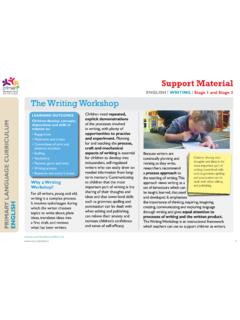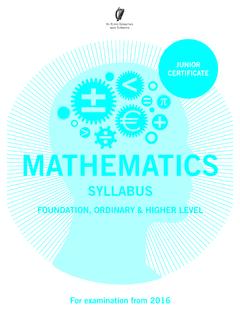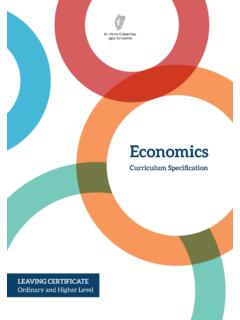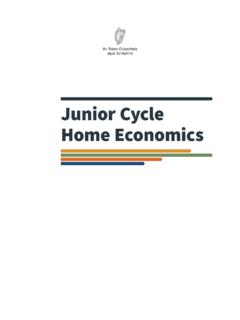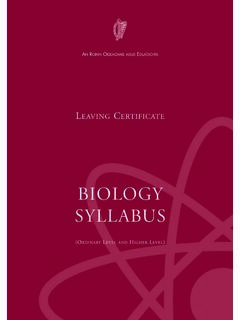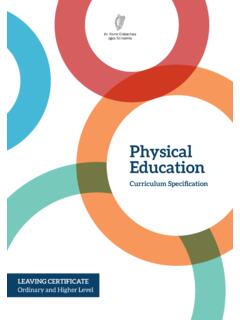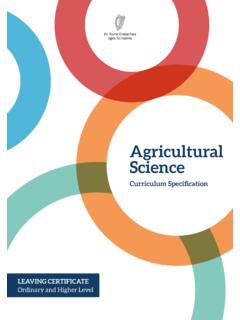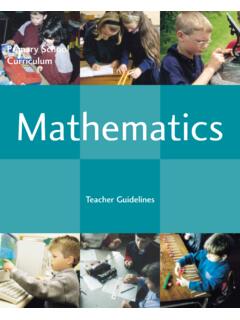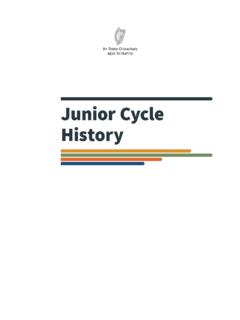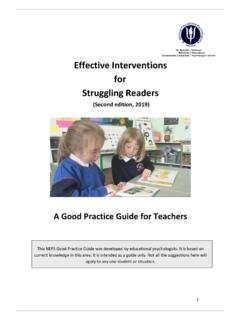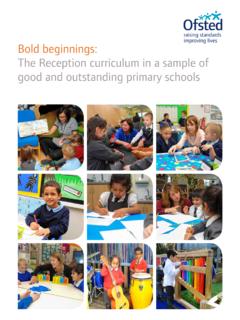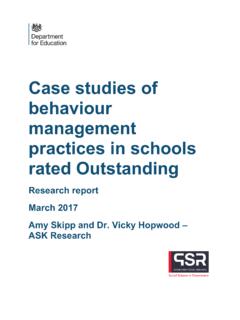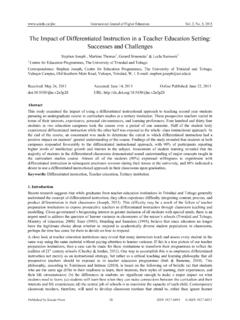Transcription of Short Course Physical Education - Curriculum
1 Short CoursePhysical EducationSpecification for Junior CycleJune 2016 PagePagePagePagePagePagePagePageContents 3 Introduction to junior cycle4 Rationale5 Aim6 Overview: Links Statements of LearningKey Skills9 Overview: Course10 Expectations for studentsLearning Outcomes15 Assessment and reporting17 Appendix 1: Level indicators for Level 3 of the National Framework of QualificationsJunior Cycle SpecificationPhysical Education3 Introduction to junior cycleJunior cycle Education places students at the centre of the educational experience, enabling them to actively participate in their communities and in society, and to be resourceful and confident learners in all aspects and stages of their lives. Junior cycle is inclusive of all students and contributes to equality of opportunity, participation and outcome for cycle allows students to make a strong connection with learning by focusing on the quality of learning that takes place and by offering experiences that are engaging and enjoyable for them, and relevant to their lives.
2 These experiences are of a high quality, contribute to the Physical , mental and social wellbeing of learners, and where possible, provide opportunities for them to develop their abilities and talents in the areas of creativity and enterprise. The student s junior cycle programme builds on their learning in primary school. It supports their further progress in learning. It helps students to develop the learning skills that can assist them in meeting the challenges of life beyond Cycle SpecificationPhysical Education4 RationaleYoung people in junior cycle are at an important stage in their lives where they are developing rapidly; physically, psychologically and socially. Increasingly, they are making their own lifestyle decisions, including whether and/or how they will participate in regular Physical activity. Physical Education can provide all students with enjoyable and worthwhile learning opportunities where they develop the movement skills and competencies to participate and perform in a variety of Physical activities competently, confidently and safely.
3 It builds students motivation in and commitment to Physical activity and sport within and beyond school. It can encourage students to get involved in both participation and leadership roles, irrespective of their previous experiences of or ability in Physical activity. In this Short Course , students learn to appreciate the importance of regular health-enhancing Physical activity and to make informed choices about how to include Physical activity as part of a healthy lifestyle. Such informed choices are key to the development of lifelong habits of Physical activity; thus student choice and consultation with students are given particular emphasis in the Course and assessment design. The Course builds on learning in Physical Education in primary school and lays the foundations for their learning in senior cycle Physical Education . This Short Course contributes to important learning in the school s Wellbeing programme within junior cycle.
4 As a result of their learning in Physical Education , students should be better able and more motivated to include regular Physical activity in their lives thereby contributing to their overall sense of wellbeing. In junior cycle, six indicators Active, Responsible, Connected, Resilient, Respected and Aware have been identified as central to students wellbeing. PE provides learning opportunities which contribute to each of these wellbeing indicators. Junior Cycle SpecificationPhysical Education5 AimThe Short Course in Physical Education aims to develop students as knowledgeable, skilful and creative participants who are confident and competent to perform in a range of activities safely. The Course aims to build students appreciation of the importance of health-enhancing and inclusive Physical activity and a commitment to it now, and in the Cycle SpecificationPhysical Education6 Overview: LinksTables 1 and 2 on the following pages show how PE may be linked to central features of learning and teaching in junior cycle.
5 PE and statements of learningTable 1: Links between junior cycle PE and the statements of learningStatementExamples of related learning in the courseSOL 12: The student is a confident and competent participant in Physical activity and is motivated to be physically active. Students become more confident and competent as they learn to participate in a range of challenging and developmentally appropriate Physical activities. They set goals and plan to improve their competence, Physical fitness and engagement in Physical 11: The student takes action to safeguard and promote her/his wellbeing and that of others. Students reflect on their own Physical activity levels and plan for regular, meaningful engagement in Physical activity. They engage in activities which promote positive relationships and which require cooperation and respect for differing learn to apply safety procedures across the variety of activities.
6 They plan, lead and take part in appropriate warm-up and cool-down 4: The student creates and presents artistic works and appreciates the process and skills involved. Students create and perform individual and group dance and/or gymnastic performances in accordance with the criteria for artistic performance. They refine their performances based on reflection and feedback. PE and key skillsIn addition to their specific content and knowledge, the subjects and Short courses of junior cycle provide students with opportunities to develop a range of key skills. The junior cycle Curriculum focuses on eight key skills. Junior Cycle SpecificationPhysical Education7 Figure 1: Key skills of junior cycleMANAGING MYSELFBEINGCREATIVEMANAGINGINFORMATION& THINKINGSTAYINGWELLCOMMUNICATINGBEINGLIT ERATEBEINGNUMERATEWORKING WITH OTHERSKEY Skills of Junior Cycle Imagining Exploring options and alternatives Implementing ideas and taking action Learning creatively Stimulating creativity using digital technology Expressing ideas mathematically Estimating, predicting and calculating Developing a positive disposition towards investigating, reasoning and problem-solving Seeing patterns, trends and relationships Gathering, interpreting and representing data Using digital technology to develop numeracy skills and understanding Being curious Gathering, recording, organising and evaluating information and data Thinking creatively and critically Reflecting on and evaluating my learning Using digital technology to access.
7 Manage and share content Being healthy and physically active Being social Being safe Being spiritual Being confident Being positive about learning Being responsible, safe and ethical in using digital technology Knowing myself Making considered decisions Setting and achieving personal goals Being able to reflect on my own learning Using digital technology to manage myself and my learning Developing my understanding and enjoyment of words and language Reading for enjoyment and with critical understanding Writing for different purposes Expressing ideas clearly and accurately Developing my spoken language Exploring and creating a variety of texts, including multi-modal texts Using language Using numbers Listening and expressing myself Performing and presenting Discussing and debating Using digital technology to communicate Developing good relationships and dealing with conflict Co-operating Respecting difference Contributing to making the world a better place Learning with others Working with others through digital technology12914 NCCA Jr Cycle Key Skills Poster 110/06/2016 12:58 This Course offers opportunities to support all key skills, but some are particularly significant.
8 The examples below identify some of the elements that are related to learning activities in PE. Teachers can also build many of the other elements of particular key skills into their classroom Cycle SpecificationPhysical Education8 Table 2: Links between junior cycle PE and key skillsKey skillKey skill elementStudent learning activityBeing creativeExploring options and alternativesStudents discuss and agree solutions to problems posed in various Physical activities. Being literate Expressing ideas clearly and accurately Students discuss different solutions to tasks in Physical Education with their numerate Gathering, interpreting and representing data Students complete statistical analysis of their own and others performance, present it graphically, and use the findings to evaluate performance and plan for improvement. CommunicatingListening and expressing myselfStudents solve problems and negotiate solutions respectfully with fellow students in a range of Physical information and thinkingGathering, recording, organising and evaluating informationStudents gather and organise data to provide evidence about their own performance and that of others.
9 They use this information to plan for myselfSetting and achieving personal goalsStudents devise and undertake plans to achieve personal or group reflect on their progress and learning and make the necessary adjustments to their wellBeing healthy, Physical and activeStudents learn to make informed decisions about their participation in Physical activity. Students learn to demonstrate care and respect for themselves and others as they participate in different activities. Working with othersCo-operatingStudents engage in a number of peer and group tasks which require co-operation to achieve common and challenging goals. Junior Cycle SpecificationPhysical Education9 Overview: CourseThe specification is structured around four strands: Physical activity for health and wellbeing; Games; Individual and team challenges; and Dance and 1: Physical activity for health and wellbeing. This strand aims to build students understanding of and commitment to regular health-enhancing Physical activity as part of a healthy lifestyle.
10 Students apply their learning as they design, implement and evaluate their own Physical activity 2: Games. This strand focuses on building students competence and confidence in two of the following games categories: divided court, invasion and striking and fielding games. Students learn how to develop a range of transferable movement skills and competencies and the ways in which these can be used within and across the different games 3: Individual and team challenges. This strand focuses on building students competence and confidence in two of the following Physical activity areas: orienteering and team challenges, aquatics and athletics. Students are encouraged to set challenging goals for themselves individually and/or as part of a team and to reflect on the experience and progress made. In this strand, schools may choose an adventure activity other than orienteering if their location facilitates this 4: Dance and gymnastics.
